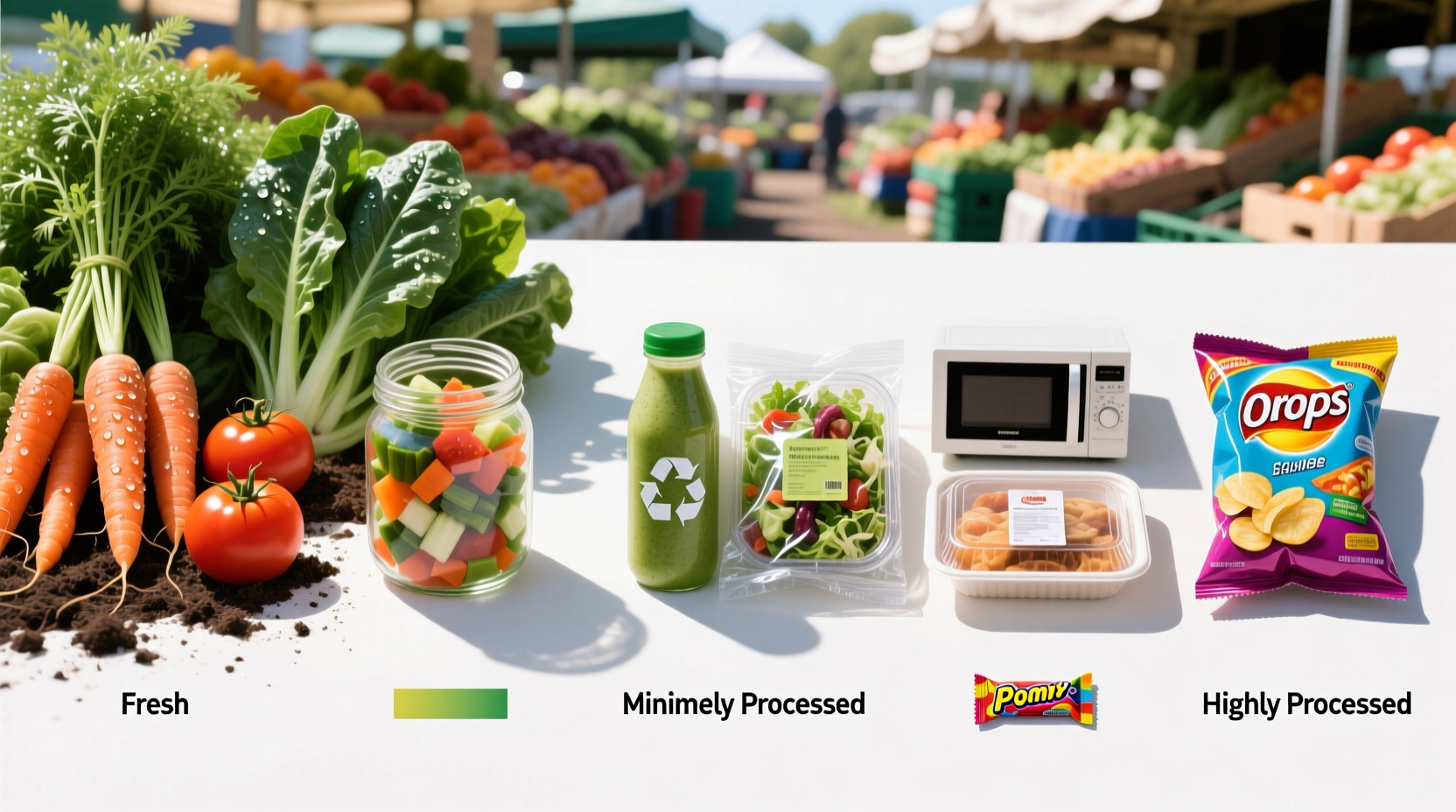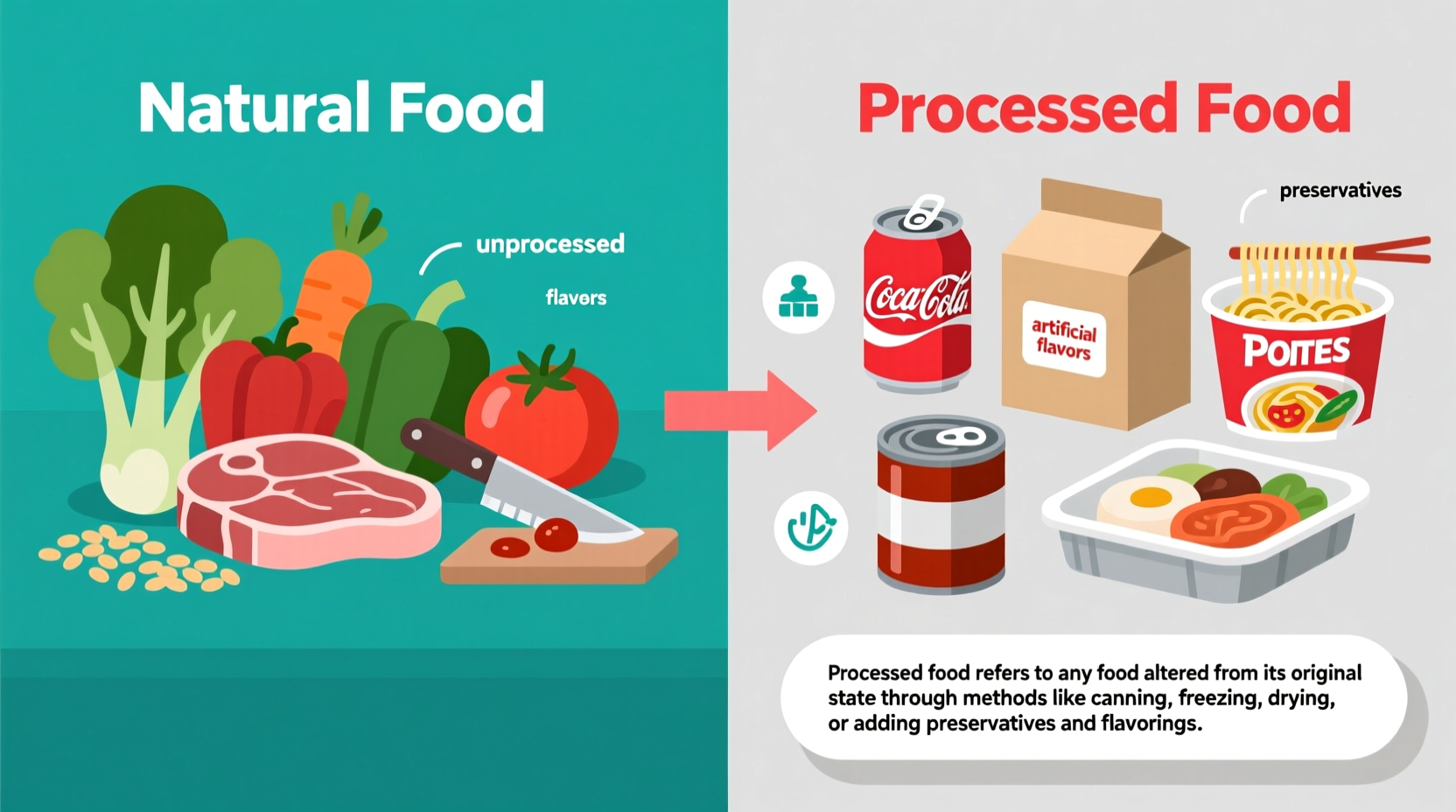Processed food means any food that has been altered from its natural state through methods like cooking, freezing, canning, or adding preservatives. This includes everything from frozen vegetables to packaged snacks, existing on a spectrum from minimally processed (like bagged spinach) to ultra-processed (like soda and candy bars).
Understanding the Food Processing Spectrum: Beyond the Binary
When you search "what does processed food mean," you're likely encountering conflicting information. The truth is, nearly all food undergoes some processing. The critical distinction lies in how much and what kind of processing occurs. Let's move beyond the oversimplified "processed = bad" narrative to understand the reality.
Why the Confusion Exists
Many people mistakenly believe "processed" automatically means unhealthy. In reality, food processing serves essential purposes: enhancing safety, extending shelf life, improving nutrition (like fortifying milk with vitamin D), and making certain foods edible (cooking grains). The problem arises with ultra-processed foods that contain numerous additives and minimal whole ingredients.
The NOVA Classification System: Science-Based Framework
Researchers use the NOVA system developed by scientists at the University of São Paulo to categorize foods by processing level. This evidence-based framework helps us understand what processed food really means:
| Processing Level | Definition | Common Examples | Typical Ingredients |
|---|---|---|---|
| Unprocessed/Minimally Processed | Natural foods with no added substances | Fresh fruits, vegetables, eggs, milk, dried beans | None or minimal (washing, freezing, pasteurization) |
| Culinary Ingredients | Substances extracted from whole foods | Olive oil, sugar, salt, vinegar | Single-ingredient extracts |
| Processed Foods | Simple preservation techniques | Canned vegetables, cheese, freshly baked bread | 2-3 ingredients including culinary ingredients |
| Ultra-Processed Foods | Industrial formulations with multiple additives | Soda, packaged snacks, ready-to-heat meals | 5+ ingredients including preservatives, colors, flavors |
How Food Processing Evolved: A Historical Timeline
Understanding what processed food means requires historical context. Food processing isn't a modern invention—it's been essential to human survival for millennia:
- 10,000 BCE: Early humans discovered fermentation, creating safer, longer-lasting foods like cheese and wine
- 1809: Nicolas Appert invented canning to preserve food for Napoleon's army
- 1920s: Freezing technology became commercially viable, revolutionizing food preservation
- 1950s: Post-war industrialization led to convenience foods like TV dinners
- 1980s-Present: Rise of ultra-processed foods with sophisticated additives and formulations

Identifying Processed Foods: Practical Recognition Guide
When evaluating what processed food means in your daily choices, focus on these practical identification methods rather than binary judgments:
Reading Ingredient Lists Effectively
The simplest rule: fewer ingredients usually means less processing. If you can't pronounce most ingredients or recognize them as whole foods, it's likely highly processed. Look for:
- Whole food ingredients listed first (like "whole wheat flour" rather than just "wheat flour")
- Familiar ingredients you'd use in home cooking
- Avoidance of long lists of additives, preservatives, and artificial colors
Context Matters: When Processing Adds Value
Not all processing is problematic. Consider these beneficial processing scenarios:
- Nutrient preservation: Flash-freezing vegetables at peak ripeness preserves nutrients better than "fresh" produce shipped long distances
- Food safety: Pasteurization eliminates dangerous pathogens in dairy products
- Nutrient enhancement: Fortifying milk with vitamin D or rice with B vitamins addresses common deficiencies
- Accessibility: Canned beans and tomatoes make nutritious ingredients available year-round
The Health Dimension: What Research Actually Shows
When exploring what processed food means for your health, the scientific consensus reveals important nuances. According to a 2021 American Heart Association statement, the concern isn't with all processed foods but specifically with ultra-processed varieties.
Key research findings include:
- Ultra-processed foods typically contain 5x more additives and 3x less fiber than minimally processed options
- Studies show people consuming >60% of calories from ultra-processed foods have 30% higher risk of obesity and related conditions
- Minimal processing (like freezing or canning) preserves or even enhances nutrient availability in many cases
Making Informed Choices: A Balanced Approach
Understanding what processed food means shouldn't lead to fear or perfectionism. Instead, adopt these practical strategies:
Smart Shopping Framework
Use this evidence-based approach when evaluating products:
- Scan the ingredient list: Can you identify and pronounce most ingredients?
- Check the first three ingredients: These make up the largest portion of the product
- Consider the processing purpose: Is it for safety (pasteurization), preservation (freezing), or convenience (multiple additives)?
- Balance with whole foods: Aim for ultra-processed foods to make up less than 20% of your diet
Practical Swaps for Common Processed Foods
You don't need to eliminate all processed foods—just make smarter choices:
- Instead of sugary breakfast cereal → Choose minimally processed oatmeal with fresh fruit
- Instead of packaged lunch meat → Select roasted chicken breast from the deli counter
- Instead of frozen pizza → Use whole-wheat tortillas with tomato sauce and fresh toppings
- Instead of soda → Try sparkling water with a splash of 100% fruit juice
Conclusion: Moving Beyond the Hype
Understanding what processed food means requires recognizing the spectrum of processing rather than labeling all processed foods as "bad." The key is focusing on how much and what kind of processing occurs. By learning to identify ultra-processed foods while appreciating the benefits of minimal processing, you can make informed choices that support your health without unnecessary restrictions. Remember that food processing has kept humans safe and well-nourished for thousands of years—the goal is smart consumption, not elimination.











 浙公网安备
33010002000092号
浙公网安备
33010002000092号 浙B2-20120091-4
浙B2-20120091-4